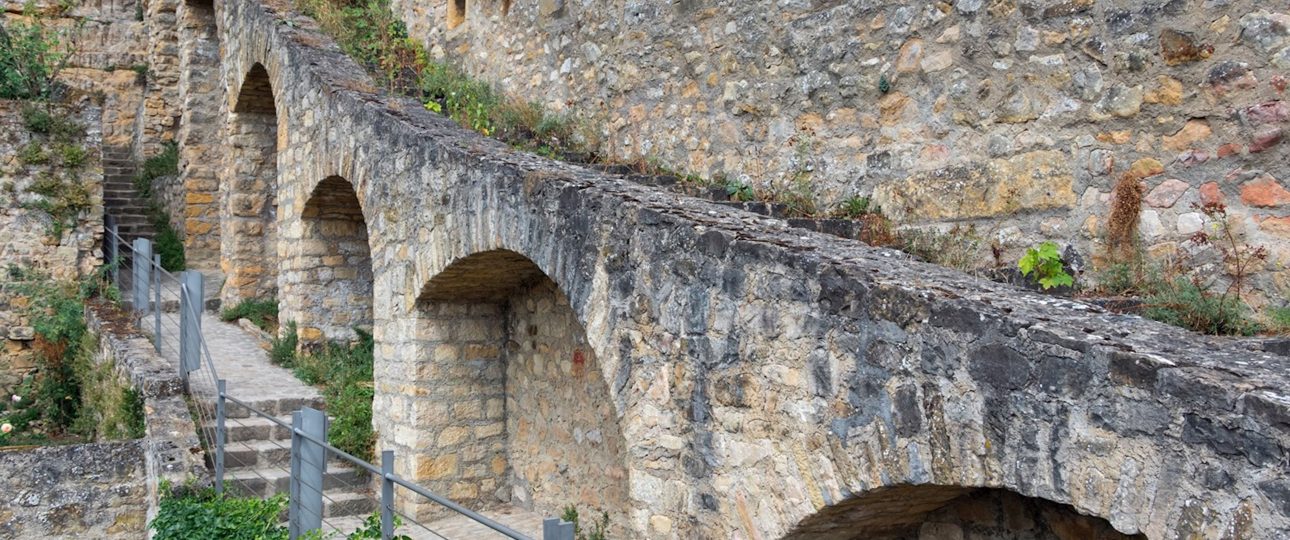Introduction to Bock Casemates
Welcome to the Bock Casemates, an integral part of Luxembourg’s rich historical tapestry. Situated in Luxembourg City, these underground fortifications offer a fascinating insight into the region’s military past and architectural prowess. As someone who has explored these tunnels firsthand, I can attest to their captivating allure and historical significance.
A Brief History
The origins of the Bock Casemates can be traced back to 963 when Count Sigfried established a castle on the Bock Promontory, laying the foundation for what would become Luxembourg City. The casemates themselves were constructed in the mid-18th century by the Austrians, enhancing the city’s defenses and earning it the nickname “Gibraltar of the North.” This impressive network of tunnels and fortifications was recognized for its historical value when it was inscribed on the UNESCO World Heritage List in 1994.
The tunnels, which extend for approximately 23 kilometers, served various purposes over the centuries, including military defense, living quarters, and storage facilities. Today, they stand as a testament to Luxembourg’s strategic importance in European history.
Exploring the Bock Casemates
What to Expect
Visiting the Bock Casemates is an opportunity to marvel at the engineering feats of the past. Here’s what you can look forward to:
- Guided Tours: Participate in a guided tour to gain a deeper understanding of the casemates’ history. Knowledgeable guides offer insights into the various sections of the tunnels.
- Archaeological Crypt: Don’t miss the archaeological crypt, which serves as an educational introduction to the casemates.
- Panoramic Views: Step outside to enjoy stunning views of Luxembourg City and the surrounding valley from the Bock Promontory.
Unique Features
The Bock Casemates are more than just tunnels; they are a symbol of Luxembourg’s historical identity. Noteworthy features include:
- Double-Level Tunnels: The casemates feature both upper and lower levels, each with distinct historical functions.
- Ventilation Shafts: Ingeniously designed shafts ensure fresh air circulation, highlighting the advanced engineering of the era.
- Historical Markers: Throughout the site, markers provide context and detail significant events in the casemates’ history.
Best Time to Visit
The ideal times to visit the Bock Casemates are during the spring (April to June) and fall (September to October). These months offer mild weather, perfect for exploring both the tunnels and the surrounding outdoor areas. Summer can be crowded with tourists, while winter’s colder temperatures might limit outdoor enjoyment.
How to Get There
Reaching the Bock Casemates is straightforward:
- By Plane: Luxembourg Airport is the nearest airport, located about a 15-minute drive from the city center.
- By Train: Luxembourg City is well-connected by train to major European cities. From the train station, you can walk or take a bus to the casemates.
- By Bus: Several local bus routes serve the area, making it easy to reach the site from various points in the city.
Local Transportation
Once in Luxembourg City, getting around is convenient with the efficient public transportation system:
- Trams: The tram network covers many areas of the city and is a convenient way to travel.
- Buses: The extensive bus system provides access to virtually every corner of the city.
- Walking: The compact nature of the city makes it easy to explore on foot, especially around the Bock Casemates.
Practical Travel Tips
Enhance your visit to the Bock Casemates with these practical tips:
- Wear Comfortable Shoes: Exploring the tunnels involves considerable walking, so comfortable footwear is essential.
- Bring a Camera: Capture the stunning views and historical features that make for excellent photography subjects.
- Check Opening Hours: Verify the current opening hours and any special events on the official website before your visit.
Nearby Attractions
While visiting the Bock Casemates, consider exploring these nearby attractions:
- The Grand Ducal Palace: A short walk away, this palace is the official residence of the Grand Duke of Luxembourg.
- Notre-Dame Cathedral: A stunning example of Gothic architecture, this cathedral is a must-see.
- Chemin de la Corniche: Known as “Europe’s most beautiful balcony,” this promenade offers spectacular views of the old town and the Alzette River.
Dining Options
After a day of exploration, refuel at one of these local dining establishments:
- Restaurant Chiggeri: Enjoy a mix of international and local cuisine in a cozy atmosphere.
- Brasserie de la Gare: Located near the train station, this brasserie offers traditional Luxembourgish dishes.
- Chez Boubou: A charming café known for its desserts and coffee, perfect for a quick break.
Conclusion
Visiting the Bock Casemates offers a journey through Luxembourg’s history, architecture, and breathtaking views. Whether you’re a history enthusiast or simply curious about Luxembourg’s unique heritage, the casemates provide a captivating experience. Don’t miss the chance to explore this remarkable site on your travels!




